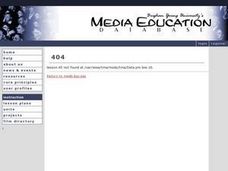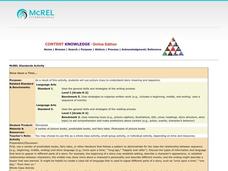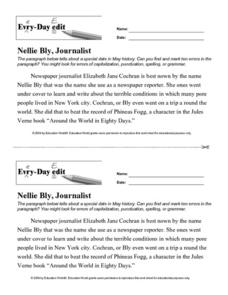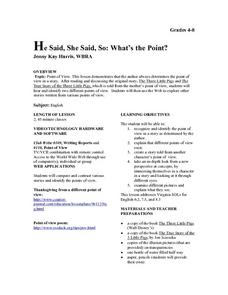Curated OER
A Friend Is...
Students investigate characteristics of friendship through literature and interviews then share their ideas through posters. They role play scenarios related to friends and problems they might have. This lesson reflects cross curricular...
Curated OER
Creating Characters: Voice
Students participate in a drama character building activity. They view and discuss a video segment, discuss the differences between the two girls in the video, and compare the two characters by saying the same phrases while pretending to...
Curated OER
Phenomenology Lesson Plan #5: Character Part 2
Students examine the meaning of the word icon as it relates to media and pop culture. They watch and discuss film clips, write a mini-biography, take a Film Icon Quote quiz, and write a written response to the film clips.
Curated OER
Phenomenology Lesson Plan #4: Character Part 1
Students examine the way they react to characters and text. They write respones to different media tests. They are required to bring in a photograph and create a mini-biography for homework.
Orange County Department of Education
Black Cowboy, Wild Horses
Fifth graders read the selection Black Cowboy, Wild Horses and identify characteristics of self-discipline shown by story's main character, Bob Lemmons. Students then identify some of their own traits of self-discipline and reflect upon...
Curated OER
The Alamo:Documenting Courage
Students discover the historical events that took place at the Alamo and consider their impact on American History. They utilize internet links and worksheets imbedded in this plan to further their understanding of the Alamo.
Curated OER
And Others?
Having integrity is often easier said than done. After completing the first lesson in a unit on being true to themselves and their values, learners engage in a discussion about three different people in difficult situations that call for...
Tellagami Labs
Tellagami
Bring the world of video messaging into your classroom with this creative communication application. Offering the ability to create animations with customized characters, backgrounds, and recorded messages, this resource is guaranteed to...
Curated OER
Once Upon a Time...
Model for emergent readers how to write a story by interpreting picture clues. For guided practice a second book is used, and then pupils work independently or with an adult to write their own stories based on illustrations.
John F. Kennedy Center
Folktale Theatre
Introduce your middle schoolers to a performance and movement activity that uses their favorite stories from fairytales and folklore. They practice basic acting skills, create dialogues with a partner, and then as guided practice,...
Education World
Every Day Edit - Donald Duck
In this everyday editing worksheet, learners correct grammatical mistakes in a short paragraph about Donald Duck. The errors range from capitalization, punctuation, spelling, and grammar.
Education World
Every Day Edit - Ezra Jack Keats
In this everyday editing learning exercise, learners correct grammatical errors in a short paragraph about Ezra Jack Keats. The errors range from punctuation, capitalization, grammar, and spelling.
Education World
Every Day Edit - Nellie Bly, Journalist
For this everyday editing worksheet, students correct grammatical mistakes in a short paragraph about journalist Nellie Bly. The errors range from capitalization, grammar, spelling, and punctuation.
Curated OER
Oliver Twist Goes to Hollywood
How does Oliver Twist, the novel written by Charles Dickens, compare with its screenplay adaptation? Although the activity doesn't require learners to have read the novel, the similarities and differences of the highlighted passages...
Curated OER
An Elephant's Life
Here is an interesting worksheet that's all about elephants. In it, learners answer ten true-or-false questions about elephants, then respond to ten questions that come from a story about Daisy, the circus elephant. The questions should...
Education World
Every Day Edit Mildred Wirt Benson
In this everyday editing worksheet, students correct grammatical mistakes in a short paragraph about author Mildred Wirt Benson. The errors range from punctuation, capitalization, grammar, and spelling.
Curated OER
Playing with Puns
"O pun" the door on this activity. Have your pupils compare the puns and word play in scenes from Shakespeare’s Twelfth Night to those in Gary Blackwood’s The Shakespeare Stealer. Warm up and introductory activities, as well as...
Curated OER
He Said, She Said, So: What's the Point?
Not by the hair on my chinny chin chin! Upper graders and middle schoolers read the story The Three Little Pigs and other tales related to the story from various points of view. They use the Internet to find more stories...
Curated OER
Fractured Fairy Tales
Through reading and writing, learners explore common elements found in fairy tales. After discussing traditional fairy tales, class members listen to The True Story of the 3 Little Pigs by John Scieszka, a hilarious retelling of the...
Curated OER
Stonewall and Beyond: Gay and Lesbian Issues
Help learners understand their own biases and how their perspectives may have been influenced by biased media sources. They keep a journal while viewing videos, exploring websites, and engaging in class discussions related to gay and...
Curated OER
To Kill A Mockingbird: Study Guide Part I
Readers of To Kill a Mockingbird summarize events, identify characters, and analyze actions in the first 11 chapters of Harper Lee’s novel. The carefully crafted questions could be used to guide reading or as the basis of group or...
Carnegie Library
Creative Writing: Middle School Lesson Plan
Enhance a unit on historical fiction with an engaging writing lesson. Learners bring the Industrial Era to life as they compose their own historical fiction pieces based on primary source images of Pittsburgh steel workers.
K12 Reader
Narrator and Point of View
Point of view is important when choosing a narrator. Help young writers distinguish between first and third person point of view with an activity that features excerpts from Robert Louis Stevenson's Treasure Island. After reading...
Roald Dahl
Matilda - Miss Trunchbull
How would you react to the Trunchbull if she was your teacher? This is the focus of an activity that has readers imagining and then acting out their reactions to various Trunchball scenarios in the story.

























